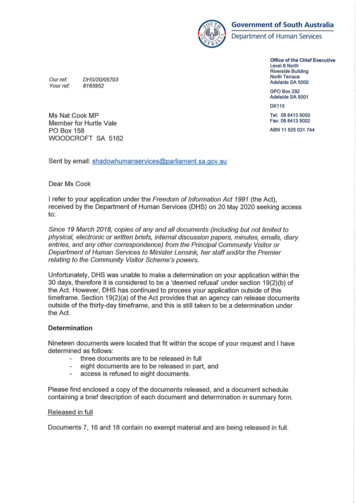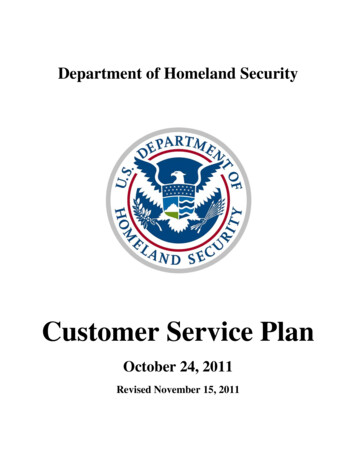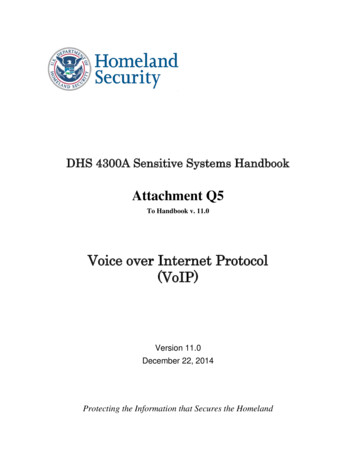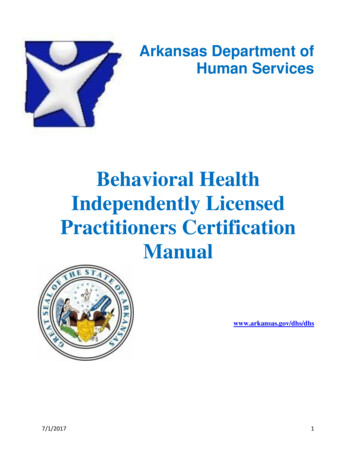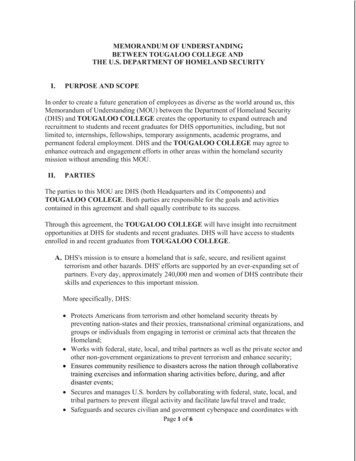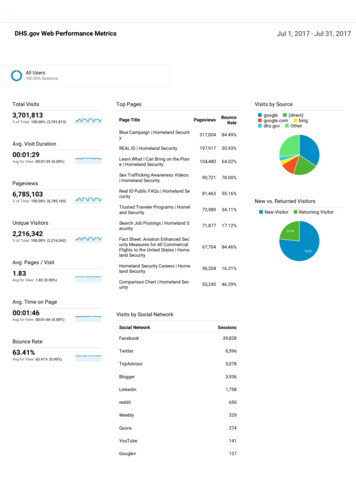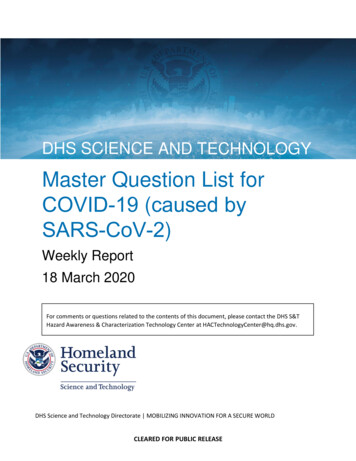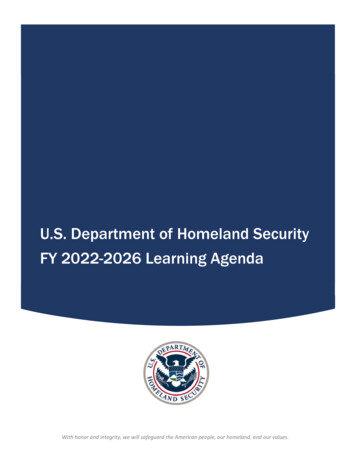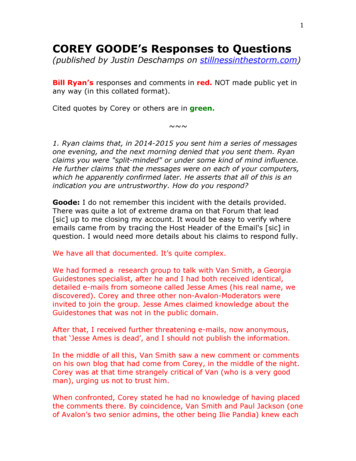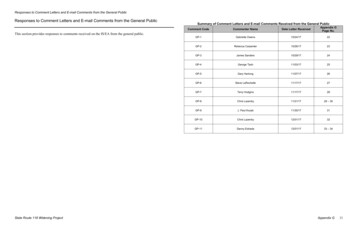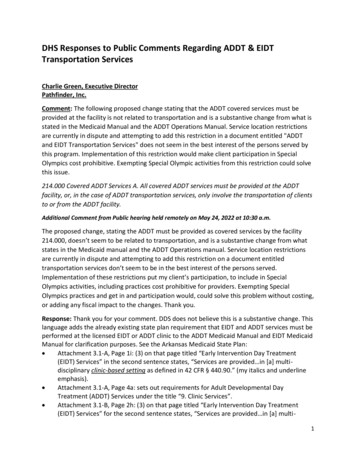
Transcription
DHS Responses to Public Comments Regarding ADDT & EIDTTransportation ServicesCharlie Green, Executive DirectorPathfinder, Inc.Comment: The following proposed change stating that the ADDT covered services must beprovided at the facility is not related to transportation and is a substantive change from what isstated in the Medicaid Manual and the ADDT Operations Manual. Service location restrictionsare currently in dispute and attempting to add this restriction in a document entitled "ADDTand EIDT Transportation Services" does not seem in the best interest of the persons served bythis program. Implementation of this restriction would make client participation in SpecialOlympics cost prohibitive. Exempting Special Olympic activities from this restriction could solvethis issue.214.000 Covered ADDT Services A. All covered ADDT services must be provided at the ADDTfacility, or, in the case of ADDT transportation services, only involve the transportation of clientsto or from the ADDT facility.Additional Comment from Public hearing held remotely on May 24, 2022 at 10:30 a.m.The proposed change, stating the ADDT must be provided as covered services by the facility214.000, doesn’t seem to be related to transportation, and is a substantive change from whatstates in the Medicaid manual and the ADDT Operations manual. Service location restrictionsare currently in dispute and attempting to add this restriction on a document entitledtransportation services don’t seem to be in the best interest of the persons served.Implementation of these restrictions put my client’s participation, to include in SpecialOlympics activities, including practices cost prohibitive for providers. Exempting SpecialOlympics practices and get in and participation would, could solve this problem without costing,or adding any fiscal impact to the changes. Thank you.Response: Thank you for your comment. DDS does not believe this is a substantive change. Thislanguage adds the already existing state plan requirement that EIDT and ADDT services must beperformed at the licensed EIDT or ADDT clinic to the ADDT Medicaid Manual and EIDT MedicaidManual for clarification purposes. See the Arkansas Medicaid State Plan: Attachment 3.1-A, Page 1i: (3) on that page titled “Early Intervention Day Treatment(EIDT) Services” in the second sentence states, “Services are provided in [a] multidisciplinary clinic-based setting as defined in 42 CFR § 440.90.” (my italics and underlineemphasis). Attachment 3.1-A, Page 4a: sets out requirements for Adult Developmental DayTreatment (ADDT) Services under the title “9. Clinic Services”. Attachment 3.1-B, Page 2h: (3) on that page titled “Early Intervention Day Treatment(EIDT) Services” for the second sentence states, “Services are provided in [a] multi1
disciplinary clinic-based setting as defined in 42 CFR § 440.90.” (my italics and underlineemphasis)Attachment 3.1-B, Page 4b: sets out requirements for Adult Developmental DayTreatment (ADDT) Services under the title “9. Clinic Services”.Attachment 4.19-B, Page 3a: sets out Methods and Standards of Care for establishingpayment rates for Adult Developmental Day Treatment (ADDT) and Early Intervention DayTreatment (EIDT) under the title “9. Clinic Services.”Leah Henderson, CEOCivitan ServicesComment: Please consider the following comments and recommendations for changes in ADDT/ EIDT Transportation: ADDT - Pg. 38, D ii: Change to read “Sign and date each transportationlog verifying that each client WHO ” as opposed to “that each client that ”Response: Thank you for your comment. Section 605(b)(3)(D) of the ADDT Rules and Section604(b)(3)(D) of the EIDT Rules will be deleted in their entirety.Comment: ADDT - Pg 41, 2 A: Consider changing to age 18 for attendants. In the past we havehad several college students who performed this job with excellence. Under this rule theywould have been disallowed employment. The job market is difficult enough now withoutadding unnecessary age limitations. (The same language is found in EIDT rules on top line ofpage 39.)Response: Thank you for your comment. DDS agrees with reducing the attendant minimum agerequirement from twenty-one (21) years of age to eighteen (18) years of age in Section605(c)(2)(A)(i)(a) of the ADDT Rules and Section 604(c)(2)(A)(i)(a) of the EIDT Rules. This is alsoconsistent with current practice and daycare licensing interpretation.Comment: ADDT – Page 42, 3 B: “Wear or have visible AN (not and) easily readable .” Also inEIDT on page 39, 3 A.Response: Thank you for your comment. DDS agrees with the suggested change to Section605(c)(3)(A) of the ADDT Rules and Section 604(c)(3)(A) of the EIDT Rules.Comment: ADDT – Page 44, 3 C: I do not feel that the State of Arkansas / Department of HumanServices should be listed as an additional insure and loss payee on all vehicles. Why should DHS2
benefit from an accident in which they have not been responsible for the payment ofpremiums? Again, this language is repeated in EIDT on page 41. C 3Response: Thank you for your comment. The DHS Office of Chief Counsel requires this provisionto provide DHS with coverage should DHS be added as a party to a lawsuit or Claims Commissionfiling in connection with ADDT or EIDT transportation services.Martha McKenzie HillMitchell, Williams, Selig, Gates & Woodyard, P.L.L.C.On behalf of the CHMS Providers’ AssociationComment: Please see the following comments on the proposed rules on ADDT and EIDTTransportation Services. Specifically regarding Proposed EIDT Rule 212.200 Prescription:For consistency within all Medicaid rules, the CHMS Providers’ Association urges inclusion of asignature of a Nurse Practitioner to be added as an accepted signature on the DMS-640.Response: Thank you for your comment. The revised Arkansas Code Annotated § 20-77-140(a)allows advanced practice registered nurses to enroll as primary care providers (PCP). As a result,the signature of an advanced practice registered nurse enrolled as primary care provider withthe Arkansas Medicaid Program would be an accepted signature on the DMS-640 pursuant to theproposed language. Additionally, the proposed language tracks the “PCP or attending physician”language that is used on the DMS-640.The language covering this topic in other program Medicaid Manuals will be changed to track thislanguage whenever those manuals are next submitted through promulgation.Comment: Specifically regarding Proposed Rule 215.000 Individual Treatment Plan (ITP)A. 3: The ECDS’s original signature and the date signed must be recorded on the ITP.The CHMS Providers’ Association urges that language including electronicsignatures should be included.Response: Thank you for your comment. Rule 215.000(A)(3) in the EIDT Medicaid Manual will berevised to delete the word “original”. Since electronic signatures are already specifically deemedacceptable in Section 202.300 of the EIDT Medicaid Manual, this would permit electronicsignatures on the ITP.Comment: Specifically regarding the Proposed Rule 215.00 Individual Treatment Plan (ITP):B.1. A. Functional, and B. Measurable. The CHMS Providers’ Association urges that the word“functional” and “measurable” be defined or clarified as standards.3
Response: Thank you for your comment. Section 215.000(B)(1)(a) of both the ADDT MedicaidManual and EIDT Medicaid Manual shall be amended to state, “Written in the form of a regularfunction, task, or activity the client is working toward successfully performing;”The Merriam-Webster definition of “measurable” is “that can be measured.” Each client goal andobjective on an ITP must be able to be measured. A client goal of using their fingers moreeffectively would not comply because the goal is not written in a way that can be measured.Whereas a client goal of holding a round ball for ten (10) seconds would be acceptable becausethat task is able to be measured. DDS believes the word “measurable” provides sufficient clarityas to how the goal or objective must be written.Comment: Specifically regarding Proposed Rule 305 Client Service Records: (b) (1)(C) The name,address, phone number, email address, and relationship of the client’s custodian or legalguardian; The CHMS Providers’ Association urges that “best efforts to ascertain the information”should be the standard when attempting to ascertain a client’s email address. Many parents andguardians do not have email addresses. Inclusion of this standard has caused review issues in thepast. A “best efforts” standard with regard to email addresses should be included. This is astandard employed by the Federal government in many instances.Response: Thank you for your comment. Section 305(b)(1)(C) of both the EIDT Rules and theADDT Rules will be amended to read, “Telephone number and, if available, email address;”Larry Stang, Executive DirectorDevelopmental Disabilities Provider AssociationComment: 230.000 Reimbursement: A. A full unit of service must be rendered to bill a unit ofservice (Added language)Scenario – James is in day habilitation from 11:00 to 11:30. He goes to lunch from 11:30 to 12:00.He then returns to day habilitation from 12:00 to 12:30. He then goes to occupational therapyfrom 12:30 until 1:15 pm. According to the language above, the provider cannot bill for the hourof day habilitation provided James. EIDT has the same added language in the Arkansas MedicaidManual for Early Intervention Developmental Treatment under 231.000 Method ofReimbursement. This has been fought over once before and it was decided that day habilitationcan be a cumulative total of day habilitation sessions during a day, as best practices encouragelimiting the length of training sessions due to shortened attention spans and ability of individualsto remain focused for extended periods of time. DDPA urges DHS/DDS to remove this additionallanguage so as not to jeopardize existing strategies for effectively delivering these type services.4
Response: Thank you for your comment. Section 231.000(C) will be added in both the ADDTMedicaid Manual and EIDT Medicaid Manual will be revised to state, “Non-consecutive periodsof service delivery over the course of single day may be aggregated when computing a unit ofservice.”Comment: 605 Transportation: Continue to require a monitor/supervisor designee to “sign off”on transportation logs to verify everyone is off the vehicle. When the last route of the day getsback to the center everyone else is gone for the day. An agency would have to pay an employeeovertime so that person can sit and wait for the van to get back to the center so they can “signoff” that no one is on the vehicle. Some latitude needs to be allowed if this situation is occurring.It looks like regulations on disqualifications for van drivers will necessitate providers runningMVR’s for all drivers annually as there are specific disqualifications that insurance companies donot flag. There is a change which requires adult maltreatment to be done every 2 (two) yearsinstead of the current 5 (five) years.Response: Thank you for your comment. Section 605(b)(3)(D) of the ADDT Rules and Section604(b)(3)(D) of the EIDT Rules will be deleted in their entirety. Additionally, Section202.200(F)(2) of the EIDT Medicaid Manual will be revised to state:“2.The driver of each vehicle must sign and date the transportation log verifying that eachclient that received transportation services from the EIDT was safely transported to and from:a.The client’s home (or other scheduled pick-up or drop-off location); orb.The EIDT facility.”Section 202.200(D)(2) of the ADDT Rules will be revised to state:“2.The driver of each vehicle must sign and date the transportation log verifying that eachclient that received transportation services on the trip was safely transported to and from:a.The client’s home (or other scheduled pick-up or drop-off location); orb.The ADDT facility.”Comment: Page 41 – Each attendant on a vehicle transporting clients on behalf of an ADDTmust meet the following requirements: A. Be at least twenty-one (21) years of age.ADDT’s can employ individuals who are 18 years of age to supervise clients at the ADDT center,but, according to this requirement, cannot supervise the same individuals on a van.Response: Thank you for your comment. Section 604(c)(2)(A) of the ADDT Rules and Section605(c)(2)(A) of the EIDT Rules will be amended to lower the minimum required attendant ageto eighteen (18) years of age. This is also consistent with current practice and daycare licensinginterpretation.5
Comment: Page 44 – Each commercial insurance policy must name Arkansas Department ofHuman Services as an additional insured and loss payee under this policy.Why? Additional insured are named on policies because they are a lender and hold title/deedto vehicle/property insured. This is not the case with DHS.Response: Thank you for your comment. The DHS Office of Chief Counsel requires this provisionto provide DHS with coverage should DHS be added as a party to a lawsuit or Claims Commissionfiling in connection with ADDT or EIDT transportation services.Comment: Page 47 – Any vehicle used by an ADDT to transport clients must have a camerasystem installed.DDPA requests a grace period for the purchase and installation of cameras for five (5) months(through December 31, 2022). A recent survey of DDPA members identified 586 vans that needto be equipped with camera systems. With limited installers we feel a grace period prior to theenforcement of this rule is warranted. Language limiting EIDT/ADDT activities in the communityis detrimental to the overall goals of day habilitation and community living. With an emphasis oncommunity participation and home and community-based services, this limitation would have tobe removed if regulators allow some limited community-based activities in the future.Response: Thank you for your comment.Comment: Transportation under NET - From the presentation Director Melissa Weatherton gaveSeptember 10, 2021, brokers in NET receive 1.50 per passenger mile 7 passenger pick-up fee.We understand Milliman has developed and the State is proposing a “rate change” for brokersunder NET. If it is lower than they get now, then that could cause real problems since clients whorely on NET to access ADDT/EIDT already have difficulty in obtaining reliable transportation atthe current rate.Response: Thank you for your comment.Comment: EPSDT Option – DDS/Medicaid should disclose in the EIDT manual that if a child doesnot qualify for therapy or nursing, they may still qualify for day habilitation in EIDT by makingapplication under the EPSDT process DDS presented to the court. It cannot be a “real” process ifit is not disclosed openly. There should at least be a link to the EPSDT section.Response: Thank you for your comment. The process is set out in Section 214.200 of the ChildHealth Services (EPSDT) Medicaid Manual. It would be outside of standard practice andpotentially confusing to include information about another Medicaid program with a completely6
different set of program coverage eligibility criteria and service offerings within the EIDTMedicaid Manual.Comment: “Other Appropriate Location” – Under 202.200 in ADDT and EIDT manuals it says theclient must be picked up at home, the ADDT center, or “other appropriate location.” Can youplease clarify “other appropriate location”?Response: Thank you for your comment. Section 605(b)(3)(D) of the ADDT Rules and Section604(b)(3)(D) of the EIDT Rules will be deleted in their entirety. Additionally, Section202.200(F)(2) of the EIDT Medicaid Manual will be revised to state:“2.The driver of each vehicle must sign and date the transportation log verifying that eachclient that received transportation services from the EIDT was safely transported to and from:a.The client’s home (or other scheduled pick-up or drop-off location); orb.The EIDT facility.”Section 202.200(D)(2) of the ADDT Rules will be revised to state:“2.The driver of each vehicle must sign and date the transportation log verifying that eachclient that received transportation services on the trip was safely transported to and from:a.The client’s home (or other scheduled pick-up or drop-off location); orb.The ADDT facility.”Comment: Page 47 – Each vehicle used to transport a client must prominently display: A. ADDTname. B. ADDT contact information.Vehicles are interchanged among programs from time to time due to servicing requirements,repairs, and use of vehicles in multiple programs. It makes much more sense to have the nameof the organization and contact information to be on the vans, and not specific programs. Thesecomments should also apply to any similar EIDT regulations and rules that mirror those found inthe ADDT regulations and rules.Response: Thank you for your comment. Section 604(e)(5) of the EIDT Rules and Section605(e)(5) of the ADDT Rules will be amended to state:“(5) Each vehicle used to transport a client must prominently display:(A)Provider name; and(B)Provider contact information.”Amy Denton, Pediatrics PlusBess Ginty, Kids for the FutureMary Katherine Hardin, Stars Academy7
Bill Sims, Grow Learning CentreJustin Allen, Wright Lindsey JenningsComment: 101.(c)(2) DPSQA may perform regulatory functions regarding the monitoring ofchildcare centers that are licensed as Early Intervention Day Treatment programs on behalf ofDCCECE.A sentence needs to be added that the DPSQA staff member must be adequately trained in orhave experience with early childhood classrooms before monitoring on behalf of DCCECEResponse: Thank you for your comment.Comment: 103.(23) “Serious injury” means any injury to a client that: May cause death; Mayresult in substantial permanent impairment; Requires hospitalization; or Requires the attentionof: (i) An emergency medical technician; (ii)A paramedic; or (iii) A doctor.(iii) is too broad we may send a family to check on something minor or rule outsomething just because a doctor is needed, doesn’t make it serious. If the injury requires adoctor, then we would be sending them to the emergency room. Can this read “emergencyroom physician?”Response: Thank you for your comment. Section 103(23)(D)(iii) of the EIDT Rules and Section103(15)(D)(iii) of the ADDT Rules will be changed to read “An emergency room.”Comment: 201.(a)(1) An EIDT must have an EIDT license issued by the Division of Provider Servicesand Quality Assurance, pursuant to these standards, for the location at which the EIDT will provideservices. 201.(b)(1) An EIDT license is specific to a single location.Location needs to be defined as being at a different addressResponse: Thank you for your comment. Section 201(a)(1) and Sections 202(b)(1) through (3) ofboth the EIDT Rules and ADDT Rules will be amended to replace the word “location” with theword “address” wherever used.Comment: 202. (a)(1)(E) Documentation of all required Child Maltreatment Central Registrychecks and Adult and Long-term Care Facility Resident Maltreatment Registry checks foremployees and operators;Please clarify if this is a new title for this check, or is this two separate checks? The check wecurrently complete is called the Arkansas Adult Maltreatment Central Registry.8
Response: Thank you for your comment. It is just a single check. Arkansas Code Annotated § 1212-1716 refers to the registry as the Adult and Long-term Care Facility Resident MaltreatmentCentral Registry, so that is the term that will be used throughout in the ADDT Rules and EIDTRules. For that reason, Section 302(c)(3) of the ADDT Rules will be changed to use the term “Adultand Long-term Care Facility Resident Maltreatment Central Registry” for consistency purposes.Comment: 302.(c)(5) An EIDT must conduct an Arkansas Sex Offender Central Registry search oneach employee prior to hiring and at least every two (2) years thereafter.Clarify if this is a form we need to complete or just review the registry and print that the personis not on it.Response: Thank you for your comment. Printing the page from the registry showing a searchwas conducted and the employee or applicant searched was not on the registry is one methodof complying with Section 302(c)(5). However, nothing would prohibit a provider from creatinga form that could be completed with information sufficient to demonstrate a registry searchwas performed and the employee or applicant searched was not on the registry that would alsocomply with Section 302(c)(5).Comment: 302.(f)(2) The documentation required for Employee staffing includes withoutlimitation employee: (A) Names; (B) Job title or credential; (C) Shift role; (D) Shift days; and (E)Shift times.Is an offer letter or documentation with days/hours of employment sufficient here? Most EIDTstaff work set hours/days, not in shifts.Response: Thank you for your comment. Section 302(f)(2) of both the EIDT Rules and ADDTRules will be amended to state:“(2) The documentation required for Employee staffing includes without limitation employee:(A)Names;(B)Job title or credential;(C)Job duties; and(D)Typical working days and hours.”Comment: 604.(b)(1)(B) Notwithstanding the foregoing, a three to one (3:1) minimum client toattendant ratio is required for clients three (3) years of age or younger, on any vehicle used by anEIDT for transportation.This ratio is intended for infants and toddlers. This language requires this ratio up to 4 years old.It needs to be consistent with the CCL manual which reads: “In a vehicle transporting infants and9
toddlers, the driver may be counted in the staff to child ratio but shall not be the only adult. Aratio of one (1) adult for each of the three (3) infants and toddlers shall be maintained.”Response: Thank you for your comment. Section 604(b)(1)(B) of the EIDT Rules will be amendedto state:“(B)(i)Notwithstanding the foregoing, a three to one (3:1) minimum client to attendant ratio isrequired for clients under three (3) years of age on any vehicle used by an EIDT for transportation.(ii)The driver may be counted towards the minimum client to attendant ratio for thesepurposes, but under no circumstances can the driver be the only adult on a vehicle transportingone (1) or more clients under three (3) years of age.”Comment: 604.(b)(4)(B)Any vehicle, with a maximum capacity of more than seven (7)passengers and one (1) driver, that is used by an EIDT to transport clients, must have the driveror an attendant complete a walk-through inspection of each seat on the vehicle in one (1) of thefollowing ways upon arrival at the final unloading destination:These are similar to CCL but they are not good. We do not do it this way at all. We do a triplecheck that starts with the attendant checking all seats and engaging the seatbelts/straps on everyseat on the van, followed by someone from inside the building and this person deactivates thealarm, and then the driver checks the van. So, I’m not sure if we should try and change thewording or I’ll just keep doing what I do and if they tell me it isn’t what we need to be doing, gofrom there.Response: Thank you for your comment. The requirements track those in the childcare licensingregulations.Comment: 604.(d)(3)(C) Each commercial insurance policy must name the Arkansas Departmentof Human Services as an additional insured and loss payee under the policy.This should not be necessaryResponse: Thank you for your comment. The DHS Office of Chief Counsel requires this provisionto provide DHS with coverage should DHS be added as a party to a lawsuit or Claims Commissionfiling in connection with ADDT or EIDT transportation services.Comment: 604.(d)(3)(E) Each vehicle used to transport a client must have the following safetyequipment on board: (A) Fire extinguisher (B) First-aid kit (C) Reflective triangles (D) Flashlight;and (E) Reflective safety.10
**This is incorrectly cited. This should be 604.(d)(5)(E)? And, this needs to be clarified –reflective safety, what?Response: Thank you for your comment. The formatting and numbering of EIDT Rules Section604 was thrown off as part of the markup. Additionally, the word “vest” was accidentallyomitted from the subsection mentioned in the comment. (E) should state “Reflective safetyvest.” The formatting will be corrected, and the word “vest” inserted in what will be EIDT RulesSection 604(e)(1)(E) after the words “Reflective safety.”Comment: (B) The safety alarm device must: (i)Always be in working order and properlymaintained; (ii)Installed so that the driver is required to walk to the very back of the vehicleto reach the switch that deactivates the alarm; (iii) Be installed in accordance with the devicemanufacturer’s recommendations; and (iv) Sound the alarm for at least one (1) minute after theactivation of the safety alarm device.This one also seems to be incorrectly cited. Can (B) (ii) read: “Driver or designee” It is not alwaysthe driver that deactivates that alarm. It could be a designated person that checks the van whichis someone from inside the building as a second check. Never does the driver or rider deactivatethe alarm.Response: Thank you for your comment. The formatting and numbering of Rule 604 was thrownoff as part of the markup and will be corrected. The Section referred to in the comment will beSection 604(e)(3)(B)(ii). This language tracks that used in Section 1301(14) of the childcarelicensing regulations.Comment: 701.Incidents to be Reported. (a) An EIDT must report all alleged, suspected,observed, or reported occurrences of any of the following events:This language needs to be clarified. The incident report needs to be completed when the incidentoccurs when the client is in the care of/under the supervision of the EIDT center, otherwisetechnically we would need to report 701.(a)(6) and (7) every day for every client when they gohome. And, we cannot accurately fill out a report if we did not witness the incident. We can callthe hotline for any incident that is reported to us that we do not witness for anything that needsto be investigated.Response: Thank you for your comment. The introductory sentence to Section 701(a) of the EIDTRules will be amended to state, “An EIDT must report all alleged, suspected, observed, orreported occurrences of any of the following events while a client is in the care or under thesupervision of an EIDT:”. The introductory sentence to Section 701(a) of the ADDT Rules will beamended to state, “An ADDT must report all alleged, suspected, observed, or reported11
occurrences of any of the following events while a client is in the care or under the supervisionof an ADDT:”Comment: 702.Reporting Requirements. (a) An EIDT must: (1) Submit all reports of thefollowing events, within one (1) hour of the event: (A) Death of a client; (B) Serious injury to aclient; or (C) Any incident that an EIDT should reasonably know might be of interest to the publicor the media. (2) Submit reports of all other incidents within forty-eight (48) hours of the event.This language needs to be clarified. We need the same language here where we report incidentsthat occur when a client is in the care of/under the supervision of the EIDT center. We cannotaccurately fill out a form for a report if we did not witness an incident. We can call the hotline forany incident that is reported to us that we do not witness for anything that needs to beinvestigated.Response: Thank you for your comment. The introductory sentence to Section 701(a) of the EIDTRules will be amended to state, “An EIDT must report all alleged, suspected, observed, orreported occurrences of any of the following events while a client is in the care or under thesupervision of an EIDT:”. The introductory sentence to Section 701(a) of the ADDT Rules will beamended to state, “An ADDT must report all alleged, suspected, observed, or reportedoccurrences of any of the following events while a client is in the care or under the supervisionof an ADDT:”.Comment: 202.200 EIDT Documentation Requirements D.EIDTprovidersmustmaintain in each client’s service record the following documentation for all day habilitative andnursing services performed pursuant to Sections 214.120 and 214.140 of this manual: 1. Thespecific services furnished each day; 2. The date and beginning and ending time for each of theservices performed each day; 3. Name(s) and credential(s) of the person(s) providing each serviceeach day; The relationship of each day’s services to the goals and objectives in the client’s ITP;and *#4 has created some problem in audits due to the interpretation. Can we take out the word“relationship” and state “the goals and/or objectives from the client’s ITP that the dayhabilitation services are addressing.*We need to clarify #4 and #5Response: Thank you for your comment. EIDT Medicaid Manual Section 202.200(D)(4) and ADDTMedicaid Manual Section 202.200(B)(4) will both be amended to state, “Which client ITP goal(s)and objective(s) the day’s services are intended to address; and”12
Comment: 212.200 Prescription. A. Covered EIDT services require a written prescription signedand dated by the client’s primary care provider (PCP) or attending licensed physician. B. Theprescription must identify the client’s medical needs that covered EIDT services can address.*We are concerned about how this might be interpreted, or if a physician fills out the DMS-640incorrectly. Can it just read the prescription must identify the client’s “diagnosis.” The DMS-640is completed by the physician and the language on the form reads something like diagnosisrelated to the service prescribed. We believe this language should be consistent to the languageon the DMS-640 form.*How does the script list medical needs - should we change to diagnoses, etc? Need to clear upResponse: Thank you for your comment. Section 212.200(A) of the EIDT Medicaid Manual will beamended to begin “EIDT core services require a written ”. Section 212.200(B) of the EIDTMedicaid Manual will be deleted in its entirety. Section 212.200(A) of the ADDT Medicai
the signature of an advanced practice registered nurse enrolled as primary care provider with the Arkansas Medicaid Program would be an accepted signature on the DMS-640 pursuant to the proposed language. Additionally, the proposed language tracks the "P P or attending physician" language that is used on the DMS-640.
